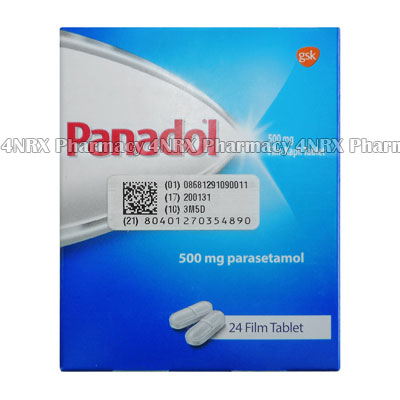 |
Home  Pain Pain  Panadol (Paracetamol) Panadol (Paracetamol) |
|
|||||||||
|
|
Panadol (Paracetamol)
What is Panadol (Paracetamol) used for? Panadol (Paracetamol) contains Paracetamol as an active ingredient, which has antipyretic and analgesic action. The mechanism of action is related to the prostaglandin synthesis inhibition, which occurs as a result of the decrease in cyclooxygenase enzyme activity. Anti-inflammatory effect of the medication is low, because Paracetamol is inactivated by cell peroxidases. Analgesic and antipyretic effects of the medication result from the decrease in the amount of prostaglandins in the central nervous system. Once the dose is administered orally, Panadol (Paracetamol) is well absorbed in the gastro-intestinal tract, and the maximum plasma concentration of the substance is registered within 30-120 minutes after administration. The degree of binding between Paracetamol and plasma proteins is low. Paracetamol is primarily metabolized in liver and excreted renally in the form of metabolites. Elimination half-time is 2-3 hours. Panadol (Paracetamol) is used to treat pain syndrome of different origin, including:
Moreover, Panadol (Paracetamol) can be used to control the influenza symptoms, including high body temperature, headache, and muscle ache. How should I use Panadol (Paracetamol)? Panadol (Paracetamol) is taken orally. It is recommended to swallow the tablets whole, without chewing or crashing them, with a full glass of water. The duration of treatment and the doses are prescribed by a physician to every patient on a case by case basis. Adults and teenagers at the age of 12 years or above are normally prescribed 500-1,000mg administered 3-4 times a day. It is recommended to keep 4-hour intervals between the doses. Children at the age of 6 to 12 years are normally prescribed 250-500mg administered 3-4 times a day. It is recommended to keep 4-hour intervals between the doses. Maximum daily dose for adults is 4,000mg, while for children at the age of 6 to 12 years it is 2,000mg. If it is necessary to take the medication for over 3 days in a row, make sure to consult your physician. It is not advisable to keep taking the medication for over 7 days in a row. The doses may need to be adjusted in patients suffering from liver and/or kidney disorders. What are the side effects of Panadol (Paracetamol)? Panadol (Paracetamol) is usually well tolerated by patients, however in some cases side effects may develop. Gastrointestinal tract and liver: Nausea, vomiting, pain in the upper abdomen, increase in the activity of liver enzymes. Hematopoietic system: Anemia, including hemolytic anemia, agranulocytosis, thrombocytopenia, pancytopenia. Moreover, methemoglobinemia, accompanied by such symptoms as cyanosis, shortness of breath, and cardialgia, may occur. Allergic reactions: Skin rash, itching, hives, erythema multiforme, toxic epidermal necrolysis, and anaphylactoid reactions. Other: Decrease in the glucose blood levels, reaching hypoglycemic coma, bronchial spasm (occurring primarily in patients with hypersensitivity to non-steroid anti-inflammatory drugs), renal papillary necrosis, and interstitial nephritis. Panadol (Paracetamol) may also affect the laboratory counts of blood sugar and uric acid. Please Note
Panadol (Paracetamol) must not be used in children under the age of 6 years. Panadol (Paracetamol) should not be prescribed to patients, suffering from alcohol addiction. Panadol (Paracetamol) should be prescribed with caution to patients with liver and/or kidney disorders. 
|
||||||||||||||||||||||